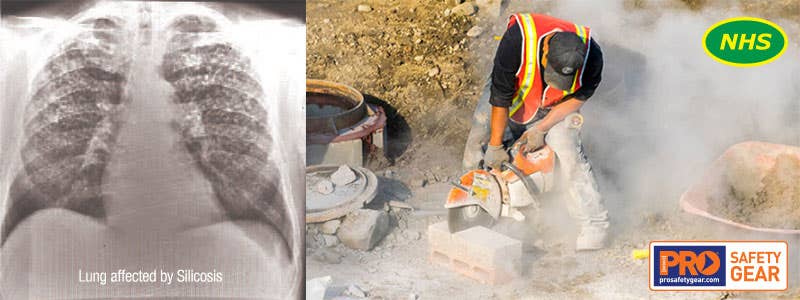WHAT IS SILICA AND WHERE IS IT FOUND?
Crystalline silica also referred to as silica/quartz is a very common mineral. Its can be present in soil, sand, granite, concrete, stone/rock, clay, artificial stone, glass, some plastic materials and many other building materials commonly used with everyday construction.
Silica is the second most common mineral in the earth’s crust and has been used in the construction industry since the early 1700’s.
When these construction materials are worked on, silica tends to be released in an extremely fine dust. Often these dust particles are 100 times smaller than a grain of sand. Construction workers could be exposed to the tiny particles of silica when cutting, drilling, sanding, demolishing or mining materials that contain silica.
This list of products may contain silica:
- Asphalt
- Brick
- Cement
- Concrete
- Fibre cement
- Grout
- Shotcrete
- Mortar
- Plaster
- Glass
- Rock
- Concrete roof tiles
- Sand
- Soil
- Stone (granite, limestone, quartzite, shale, slate)
- Tiles
HOW DOES SILICA AFFECT THE BODY?
Silicosis is a lung affliction caused by breathing dust which contains fine particles of crystalline silica. If silica particles are inhaled, they become embedded in the lungs. The lung tissues react by developing fibrotic nodes and scarring around the trapped particles. The scar tissue makes the lungs hard and stiff. Finally, this scaring can greatly reduce the function of the lungs, making it difficult and sometimes painful to breathe.
Silicosis comes in three forms:
- Chronic Silicosis: The most common form of disease, it may go undetected for years in the early stages. Chest x-rays may not reveal any signs until 15-20 years post exposure. Once the process of silicosis has commenced the progression can be slowed however, the disease can not be cured.
- Accelerated Silicosis: This type of silicosis tends to develop 5-10 years post exposure to high concentrations of crystalline silica dust. Lung x-rays and symptoms are often similar to chronis silicosis, but the onset appears faster and the disease accelerates quickly (hence the name).
- Acute Silicosis: Acute silicosis appears rapidly following extreme exposure to high concentrations of crystalline silica. In some cases, silicosis symptoms can become prevalent only weeks after exposure.
- Breathing silica dust can also cause lung cancer & increase the chance of developing Tuberculosis.
-
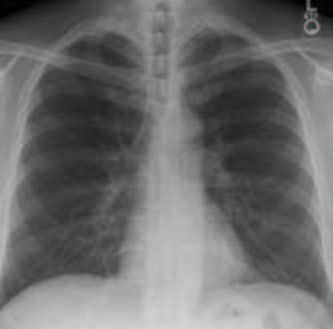
X-ray showing a normal healthy lung -
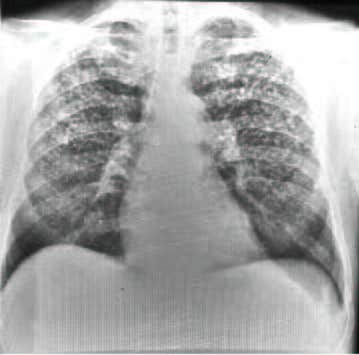
X-ray showing silicosis
WHAT ARE THE SYMPTOMS OF SILICOSIS?
Although the severity and frequency of symptoms can vary among patients at the time of diagnosis, the most common Silicosis symptoms include:
- Chronic dry cough
- Shortness of breath
- Weight loss
- Chest pain
- Fever
- Dark spots appearing in nails
- Low blood oxygen levels
- Bluish skin
HOW CAN I PROTECT MYSELF FROM SILICOSIS?
Many people who have been exposed to crystalline silica think it’s too late to take steps to avoid developing silicosis and other related illnesses, but this is a common misconception.
There are several actions you can take to lower your risk:
- Offer respiratory protection if exposure limits are exceeded
- Provide awareness training
- Provide medical surveillance
- to workers
- exposed to silica.
- Perform air monitoring and keep records
- Complete regular assessments of risks
- Communicate hazards to workers
- Use proper work practices and controls to limit exposures
SUITABLE RESPIRATORY DEVICES FOR PROTECTION FROM SILICOSIS
Like all airborne contaminates, the type of adequate respiratory protection is highly dependent on the amount of contaminate found at the location where duties are carried out. Air sampling, along with a risk assessment should be undertaken prior to commencing the removal of any silica materials.
The major element to increased protection from silica particles is to limit the amount of particles becoming airborne. Many professionals utilise water spraying, vacuuming or ventilation. These measures can reduce dust exposures by up to 80%.
The type of respiratory protection device used for adequate protection is heavily dependent on the removal process and the amount of airborne particles.
It is always recommended that when choosing a suitable respiratory protection device that overprotection is the best protection.
Please refer to the below recommendation from ProChoice, to assist with your respiratory protection requirements.

PAPR = Powered Air Purifying Respirator
RMPF is determined by the combination of the measured dust concentration and the workplace exposure standard by the simple formula:

Examples in determining the level of respiratory protection needed:

AUSTRALIAN STANDARDS REQUIREMENTS FOR FIT TESTING
AS/NZS 1715:2009 should play a part in all respiratory programs to ensure the program administrator understands the guidelines required to facilitate a comprehensive respiratory program. AS/NZS 1715:2009 Respiratory Program includes:
- a. Appointment of Program Administrator
- b. Selection of Respiratory Protection Equipment (RPE)
- c. Medical Screening of Users of Respiratory Protection Equipment
- d. Training
- e. Issuing of RPE
- f. Fitting of RPE
- g. Wearing of RPE
- h. Maintenance of RPE
- i. Disposal of equipment
- j. Record keeping
- k. Program evaluation
All requirements for the above program are detailed in AS/NZS 1715:2009.
FITTING OF RESPIRATORY PROTECTION EQUIPMENT
It’s important to understand the difference between a Fit Check and Fit Test.
Fit Check: Carried out prior to entering a contaminated area and should be part of the wearers donning routine to determine if the respirator is providing an effective seal. This check is carried out every time the respirator is used. A Fit Check follows a successful Fit Test result.
-

Negative Pressure Fit Check:
Cover filter inlets and try
to inhale -

Positive Pressure Fit Check:
Cover exhalation valve and
try to exhale
Fit Test: Provides the wearer with a pass or fail result on the respirators ability to seal effectively against the wearers face. There are two types of Fit Tests - Qualitative and Quantitative.
Qualitative tests are usually simple and fast but may be influenced by the wearer.
Quantitative tests are not subjective or influenced by the wearer, however, involves the purchase of expensive equipment and a fully trained operator.
Records of either tests must be kept for each wearer and stored to form part of the respiratory program.
A Fit Test should be performed at appropriate intervals:
- When there is a change in the wearer’s facial characteristics, eg weight loss/gain or removal of teeth.
- Before the respirator is used by the wearer to ensure the chosen respirator is suitable.
- A further fit test should be performed at least once annually.
-
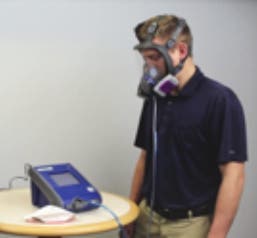
Qualitative Fit Test -
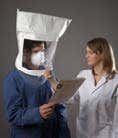
Quantitative Fit Test
images
PUTTING IT ALL TOGETHER - WHY SILICA IS HAZARDOUS
- It’s found in many construction materials
- Silica dust travels deep into your lungs
- Long time exposure to small amounts causes harm
- Short-time exposure to large amounts causes harm
- It causes lung disease, cancer, even death
- Airborne particles are too small to see
- The effects are worse if you also smoke


